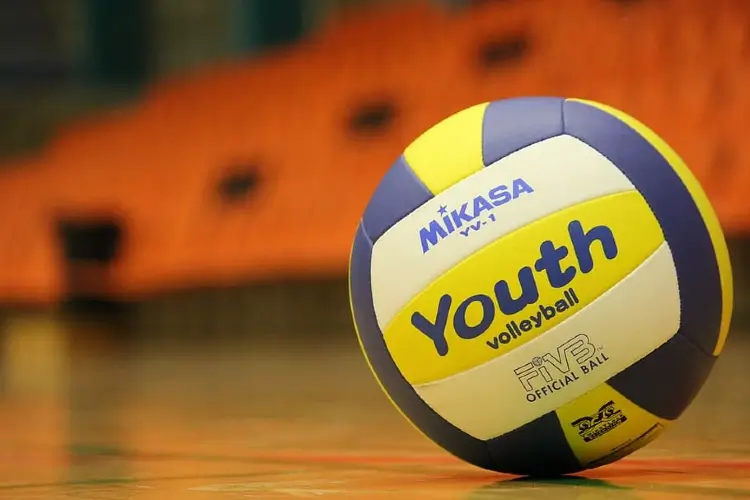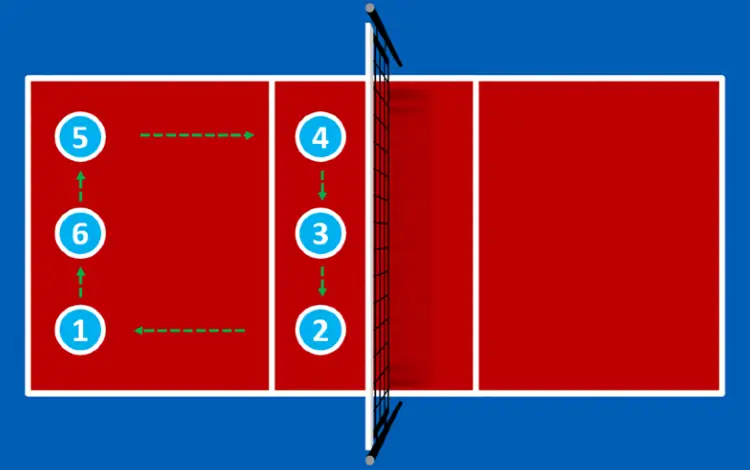Last Updated: February 29, 2024
Volleyball is a fascinating sport that is played all over the world. The team sport is played in various formats, disciplines, and on different types of surfaces. It has evolved into an indoor, beach, or sitting game.
Regardless, the sport has one set of core rules that a team must adhere to while in a match. The International Volleyball Federation (FIVB), the body that governs and sets guidelines for volleyball, has standard rules for international and official games.
Knowing the rules that govern and guide volleyball may help you to enjoy the sport as an observer, coach, or player.
Volleyball Rules and Regulations

Various rules and regulations that entrench discipline and professionalism in volleyball include the following:
Number of Players
The total number of players on a volleyball court during a game is 12—six players on each side. The middle of the court is separated by a net suspended over the center line. The players on one side belong to the same team and play against the opponent team, across the net.
Starting a Game
At the start of a match, the referee does a pre-game toss to determine which team serves first. The server, an offensive player, serves the ball to put it in play to start a rally. The shot must go across the net to the opponent’s court.
Often, teams use a serve to put the team in a strategic position to score a point. For instance, the server may use a powerful and deceptive hit, serve to the weakest passer on the other team, or serve to an empty spot.
Common serving rules:
 A coin toss decides the team to do the first serve of the first set. The other team does the first serve for the second set and so on.
A coin toss decides the team to do the first serve of the first set. The other team does the first serve for the second set and so on. The back-right player is the one that serves to put the ball to play
The back-right player is the one that serves to put the ball to play The service zone is about 10ft wide and located behind the end line
The service zone is about 10ft wide and located behind the end line A player serves the ball within eight seconds of assuming the serve position in the serving zone
A player serves the ball within eight seconds of assuming the serve position in the serving zone The server can play an overhand, underhand, stay on the ground, or jump to serve
The server can play an overhand, underhand, stay on the ground, or jump to serve The serving team scores a point if the ball hits the ground on the court of the receiving team
The serving team scores a point if the ball hits the ground on the court of the receiving team When a team scores, the same team serves
When a team scores, the same team serves When the same team that served scores a point, the same player that served serves the ball again
When the same team that served scores a point, the same player that served serves the ball again If a team serves and the receiving team scores in the rally, the players of the receiving team rotate positions for the next player to serve
If a team serves and the receiving team scores in the rally, the players of the receiving team rotate positions for the next player to serve Dribbling, moving the ball around before the serve, tossing it with two hands, or hitting it twice are illegal
Dribbling, moving the ball around before the serve, tossing it with two hands, or hitting it twice are illegal
Ball Contacts Rules
Each team can have three contacts with the ball before shooting it to the opponents. The players can touch the ball with any part of the body. When a team has the ball, a single player should not touch the ball twice in a row during the three contacts. Doing so is considered a double-touch fault.
Most teams use the first contact to set up the third shot at a position to score against the other team.
A rally continues until:
- The ball hits the ground
- A team spikes or smashes the ball to score a point
- A player commits a fault, such as sending the ball out of the court
Player Positions and Rotation Rules
Each team always has six players on the court. Three players in the front row and three in the back row. The front-row players are attackers or blockers. The players spike the ball, or block attacks from the opponents.
The back-row players are defensive players. The players dig the ball or defend the team. The back-row players may attack the ball, except for the libero, before the attack line. The six players change positions as the game progresses.
Position refers to the court zones, not the player’s role as a setter, or middle blocker. The players rotate when the team serves the ball, and the receiving team scores a point.
Players switch rotating 1 position clockwise in the pattern below:
Right Back (RB-1) → Middle Back (MB-6) → Left Back (LB-5) → Left Front (LF-4) → Middle Front (MF-3) → Right Front (RF-2)

Players should be careful not to commit an overlap fault. The overlap fault happens if a player is in close proximity to other players before the ball is served. Though players may move anywhere within the court, it should only happen after the ball is set to play.
Find out more about the player positions here
Volleyball Match Scoring System
FIVB guidelines require a match to have the best of five set contests. Some matches may have a game of three sets, which typically means the winner has to score the best of the three sets. A winning team must have a lead of two points.
The five-set match plays to the fourth set until one team scores 25 points. If the two teams tie at 24-24 by the fourth set, the game plays for 15 points in the fifth. If the teams tie at 14-14 points, the game continues until one team breaks the tie with a lead of two points.
In the three-set match, the teams play two sets of 25 points each, while the third set is to score 15 points. The first team to win two sets with a difference of two points is the winner. The team that wins a point in a rally serves for the next rally.
Related: Demystifying Volleyball’s Scoring System
A team may lose points in the following instances:
- Double touch, where a player touches the ball twice in a row
- Sending the ball out of the boundary line
- Serving out of the bounds
- Making more than three consecutive contacts of the ball before sending it to the other team
Volleyball Rules Variations
Volleyball rules may vary depending on the competitiveness of the match. FVIB enforces the same set of rules in all the official and international games such as the Olympic Games, World Cup, and the World Championships.
However, the sport’s rules may vary when managed by the National Collegiate Athletic Association (NCAA) [1] at the collegiate level, the National High School Federation (NFHS) [2] for high school levels, and by USA Volleyball [3] for club games.
Beach Volleyball Rules
Beach volleyball is governed by the same FVIB rules but has some variations. [4]
Indoor and beach volleyball differ in the following ways:
1. Number of players
The first unique factor of beach volleyball is its two team players on each side. The pair players cover the entire court and alternate as servers.
Players usually opt for partners that have complementary skill sets. An excellent hitter with an average pass may partner with a player who has good passing skills.
2. Number of points
Beach volleyball plays for 21 points. The players switch courts after every 7 points. The frequent court changes balance out the effects of the environmental conditions such as the sun and wind.
3. Court dimensions
Beach volleyball courts are typically smaller than indoor courts. The ball is also slightly larger but lighter.
See the court dimensions for various setups and volleyball formats
4. Contact rules
With beach volleyball, double contacts are stricter, affecting the length of rallies. For instance, tipping the ball with an open hand is forbidden.
5. No substitutes
Unlike indoor volleyball, the beach sport does not allow substitutes. If one player is hurt, the team forfeits the match.
Sitting Volleyball Rules
Sitting volleyball is for those with a disability and it is difficult compared to the standing volleyball. A sitting player cannot run or dive for the ball. Regardless, the sport uses the same rules as the standing matches.
Differences between the sitting and standing games include the following:
Use of arms and legs
The players can use both arms and legs to run across the court. However, the players must be in contact with the ground whenever touching the ball.
Short loss of contact
A player may have a short loss of contact with the floor of the court when in defensive play.
Court size
The sitting volleyball court is ten by six meters and is subdivided into five by six meters. The attack line is two meters away from the net, while the net is about 3 feet high. For the men’s court, the net is 1.15m high, while for the women it is 1.05m.
Various Volleyball Rotations
A volleyball rotation is a team setter’s offensive strategy to score for the team. The setter may be at the front or back row. Each strategy has pros and cons.
The first number in a rotation shows the number of hitters, while the second is for the setters in a court. A team should choose a volleyball formation to match the players’ skills, styles, strengths, and weaknesses.
Below are four different types of rotations:
6-2 rotation
The 6-2 rotation has six hitters, while two are setters. The back setter is active, while the setter in the front row is a hitter. The formation is a common strategy with intermediate teams.
The benefit of the 6-2 rotations is for the team to have more natural hitters. Having two players double as hitters gives a team substitutes when a match may have a limit of substitutes.
Using the 6-2 formation may have a drawback if the two hitters that are setters are not great setters. It may also complicate the team coordination since hitters are forced to adopt two offense styles of the two setters.
See some popular 6-2 rotation formats here
5-2 rotation
5-2 rotation is a mix of 6-2 and 5-1 rotations that has gained traction lately. The hybrid and offensive approach uses five hitters and two setters to create a maximum attack. 5-2 strategy also maximizes defensive strategies, making it a popular option for competitive teams.
The 5-2 rotation benefits include the maximum use of talents within the team. The taller setter plays from the front row, while the shorter setter is positioned in the back row.
The formation has the disadvantage of less team cohesion as setters switch positions often. It is also a drawback for substitutes when two setters are on the court. The setter in the front row limits the number of spikes a team can make.
5-1 rotation
The 5-1 strategy is common in the higher levels of the sport. The formation has five hitters and one setter. The dominant setter switches positions around the court in the front or back rows. The flexible player can play offensively and defensively.
The lone setter provides a consistent offense and learns each hitter’s strengths. A dominant setter eliminates the need for a sub. When at the front row, the setter may attack when the ball is too tight near the net.
5-1 formation disadvantages include the libero playing the role of a substitute setter when the setter takes a first pass or receives a serve. The libero may not be as effective.
4-2 rotation
It is the most straightforward rotation and an ideal strategy for beginners. The formation suits a team with members who are new to each other. The approach plays with two hitters and one setter at the front and back rows.
The active setter is positioned on the right of the front row, the ideal setting position. The player has an easy time to decide when to set the ball. Players rotation is also easy since it always retains two hitters in every row.
4-2 is a predictable formation that may work against a team when playing with a superior team. The shortage of one attacker or defense player on the back row gives the opponents a chance. The front row also has fewer spikes, with only two hitters.
Volleyball Court Size
FIVB has specific measurements for a standard volleyball court. The guidelines require the court to have the following dimensions:
- Eighteen meters long and nine meters wide, or 59 feet by 29.5 feet
- The court be subdivided into two halves, each 9 meters long to make each half 9m by 9m
- The attack line separating the front and back courts should be three meters or 10 feet long from the net on both sides of the court
- For men the net height should be 2.43 meters or 7.97 feet, for women it should be 2.24 meters or 7.35 feet.
- The ball used should have a circumference of 65 to 67cm (25.5 to 26.5 inches), weigh 260 to 290 gms (9.2 to 9.9 ounces), and have air pressure of about 4.3 to 4.6 psi
Referee Calls and Signals
Volleyball has numerous referee calls and signals. A referee uses the gestures to communicate with players in a match. The players must understand the meaning behind the referee calls. You may also enjoy the sport as an observer if you know the meaning of the signals.
Some of the many referee calls may include signals to indicate a team can serve, substitute players, change courts, warn a player, and end a match, among many others. The referee may use the same calls and gestures to communicate to the other parties of the game, such as linesmen and scorers.
Conclusion
At first glance, you might think that volleyball is complicated and a bit difficult to understand with so many rules, but it couldn’t be further from the truth. Volleyball is an exciting sport that may be played as an indoor, beach, or sitting format. Its long history, adaptable and entertaining nature makes it popular globally. You can find the sport on every continent.
FIVB has standard rules that govern the sport. Though the rules are standard, they may apply in high-level matches and with superior teams. Volleyball rules may vary depending on the governing body and the level of the match.
Key games such as inter-country competitions, world championships, the World Cup, and Olympic matches enforce the rules. Being conversant with the sport’s regulations provides an opportunity to understand and enjoy games as a player, coach, or spectator.
